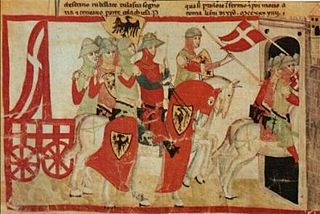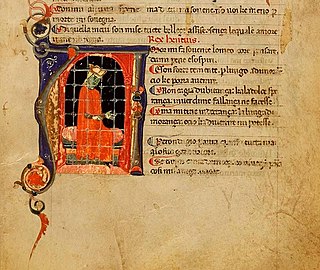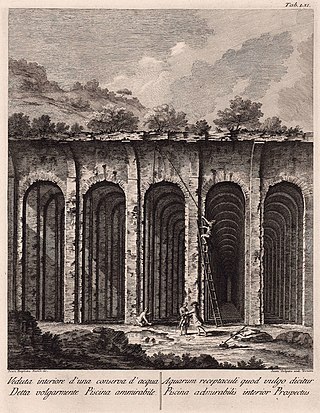
Piacenza is a city and comune (municipality) in the Emilia-Romagna region of Northern Italy, and the capital of the eponymous province. As of 2022, Piacenza is the ninth largest city in the region by population, with more than 102,000 inhabitants.

Cremona is a city and comune in northern Italy, situated in Lombardy, on the left bank of the Po river in the middle of the Pianura Padana. It is the capital of the province of Cremona and the seat of the local city and province governments. The city of Cremona is especially noted for its musical history and traditions, including some of the earliest and most renowned luthiers, such as Giuseppe Guarneri, Antonio Stradivari, Francesco Rugeri, Vincenzo Rugeri, and several members of the Amati family.

The Guelphs and Ghibellines were factions supporting respectively the Pope and the Holy Roman Emperor in the Italian city-states of Central Italy and Northern Italy during the Middle Ages.

The Lombard League was a medieval alliance formed in 1167, supported by the popes, to counter the attempts by the Hohenstaufen Holy Roman emperors to assert influence over the Kingdom of Italy as a part of the Holy Roman Empire.

The Battle of Cortenuova was fought on 27 November 1237 in the course of the Guelphs and Ghibellines Wars: in it, Holy Roman Emperor Frederick II defeated the Second Lombard League.

Ezzelino III da Romano was an Italian feudal lord, a member of the Ezzelini family, in the March of Treviso. He was a close ally of the emperor Frederick II, and ruled Verona, Vicenza and Padua for almost two decades. He became infamous as a cruel tyrant, and was, in fact, the most "notorious" of the "early tyrants".

Salimbene di Adam, O.F.M., was an Italian Franciscan friar, theologian, and chronicler. Salimbene was one of the most celebrated Franciscan chroniclers of the High Middle Ages. His Cronica is a fundamental source for Italian history of the 13th century.

Enzo was an illegitimate son of the Hohenstaufen emperor Frederick II, who appointed him 'King of Sardinia' in 1238. He played a major role in the wars between Guelphs and Ghibellines in the Imperial kingdom of Italy, and was captured by his enemies in 1249. He remained imprisoned in Bologna until his death.

The Battle of Fossalta was a battle of the War of the Guelphs and Ghibellines in Northern Italy. It took place in Fossalta, a small location on the Panaro River, and is especially remembered for the capture of Enzio of Sardinia, son of Emperor Frederick II of Hohenstaufen.

The Battle of Parma was fought on 18 February 1248 between the forces of Holy Roman Emperor Frederick II and the Lombard League. The Guelphs attacked the Imperial camp when Frederick II was away. The Imperial forces were defeated and much of Frederick's treasure was lost.

Giovanni Battista Natali, also known as Joan(nes) or Ioannes Baptista Natali, was an Italian painter and draughtsman of the late-Baroque period, active in his natal (?) city of Piacenza,[apparent contradiction] but also Savona, Lucca, and Naples, and finally Genoa in 1736.
Alberico da Romano, called Alberico II, was an Italian condottiero, troubadour, and an alternatingly Guelph and Ghibelline statesman. He was also a patron of Occitan literature.
Gregorio di Montelongo was the Bishop of Tripoli from 1249 until 1251 and the Patriarch of Aquileia from 1251 until his death.

Frederick of Antioch (c. 1223 – 1255/6) was an Italian nobleman who served as the imperial vicar of Tuscany from 1246 to 1250. He was an illegitimate son of Frederick II, Holy Roman Emperor, by an unidentified southern Italian noblewoman. He took part in the wars of the Guelphs and Ghibellines in northern Italy, and in the war over the Kingdom of Sicily following his father's death (1250).

The papal nobility are the aristocracy of the Holy See, composed of persons holding titles bestowed by the Pope. From the Middle Ages into the nineteenth century, the papacy held direct temporal power in the Papal States, and many titles of papal nobility were derived from fiefs with territorial privileges attached. During this time, the Pope also bestowed ancient civic titles such as patrician. Today, the Pope still exercises authority to grant titles with territorial designations, although these are purely nominal and the privileges enjoyed by the holders pertain to styles of address and heraldry. Additionally, the Pope grants personal and familial titles that carry no territorial designation. Their titles being merely honorific, the modern papal nobility includes descendants of ancient Roman families as well as notable Catholics from many countries. All pontifical noble titles are within the personal gift of the pontiff, and are not recorded in the Official Acts of the Holy See.
The following is a timeline of the history of the city of Piacenza in the Emilia-Romagna region of Italy.
Filippo da Pistoia, also called Filippo Fontana or anglicized Philip, was an Italian prelate, military leader and diplomat. He was the bishop-elect of Ferrara from 1239 until 1252, bishop-elect of Florence from 1250 until 1251 and archbishop of Ravenna from 1250 until his death. He was the apostolic legate in Germany between July 1246 and March 1247, in Lombardy and the Trevigiana between December 1255 and August 1258 and throughout northern Italy between 1267 and February 1270. He served as podestà (mayor) of Ravenna in 1254.
Gerardo da Sesso was an Italian monk, bishop and cardinal of the Catholic Church.
The battle of San Cesario in August 1229 was the culmination of a civil war between the members of the Lombard League. In the pitched battle, Modena and its allies defeated Bologna and its allies.
Manfred IILancia or Lança, was the eldest son of Manfred I and nominally margrave of Busca. He became an Imperial Vicar and a faithful follower of Frederick II.













